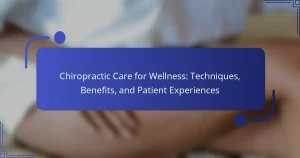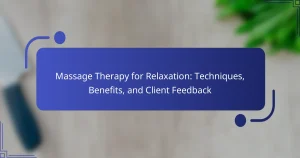Physical therapy plays a crucial role in injury rehabilitation, offering tailored approaches to enhance recovery. Key methods include manual therapy, therapeutic exercises, and modalities like ultrasound. Patients can expect improved mobility and reduced pain, with recovery timelines varying based on injury severity and treatment goals. Emerging trends such as personalized plans and telehealth services further optimize rehabilitation outcomes.
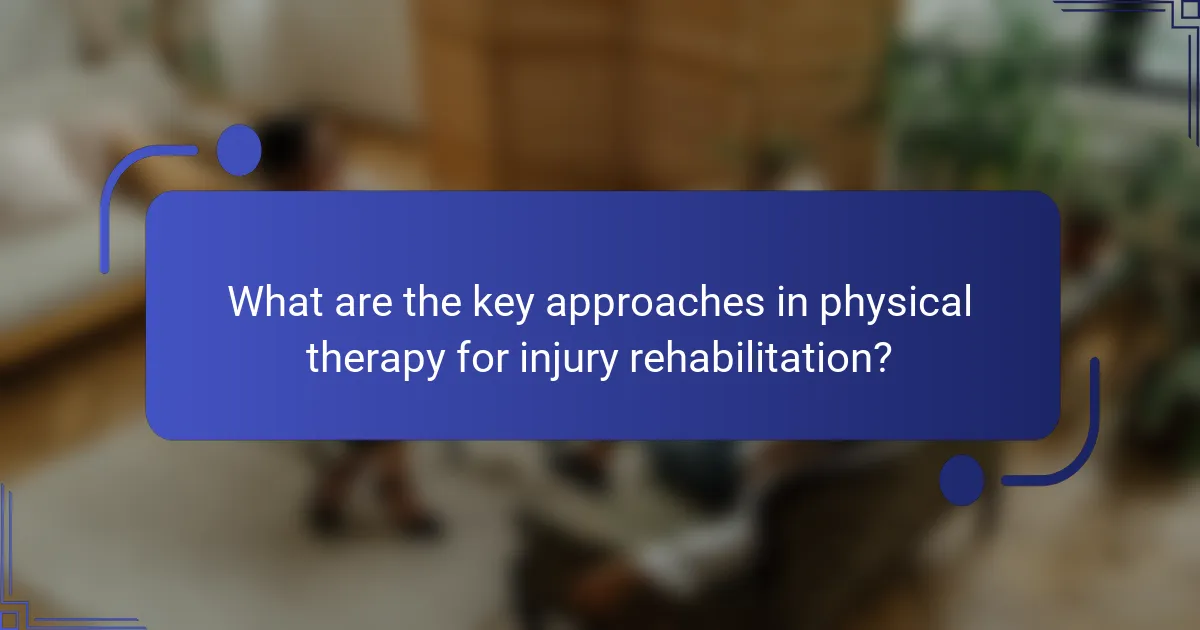
What are the key approaches in physical therapy for injury rehabilitation?
Key approaches in physical therapy for injury rehabilitation include manual therapy, therapeutic exercises, and modalities like ultrasound. These methods aim to reduce pain, improve mobility, and enhance recovery. Manual therapy involves hands-on techniques to manipulate muscles and joints, promoting healing. Therapeutic exercises focus on strengthening and restoring function, tailored to individual needs. Modalities such as heat, ice, or electrical stimulation support pain management and tissue healing. Each approach contributes to a comprehensive rehabilitation plan, optimizing recovery timelines and improving overall outcomes.
How does manual therapy contribute to recovery?
Manual therapy significantly enhances recovery by improving mobility, reducing pain, and promoting tissue healing. This hands-on approach targets specific musculoskeletal issues, facilitating faster rehabilitation. Techniques such as joint mobilization and soft tissue manipulation are effective in decreasing inflammation and increasing blood flow. As a result, patients often experience a quicker return to normal function, which is crucial in injury rehabilitation.
What role does exercise therapy play in rehabilitation?
Exercise therapy plays a crucial role in rehabilitation by enhancing recovery and restoring function. It improves strength, flexibility, and overall physical performance. Tailored exercise programs can address specific injuries, promoting healing and reducing pain. Research indicates that consistent exercise therapy leads to faster recovery timelines and better long-term outcomes. Additionally, it fosters mental well-being, encouraging adherence to rehabilitation protocols.
How is aquatic therapy utilized in injury recovery?
Aquatic therapy is utilized in injury recovery to enhance rehabilitation through low-impact exercises. This method reduces stress on joints while promoting mobility and strength. Patients experience benefits such as improved flexibility, decreased pain, and faster recovery timelines. The buoyancy of water supports movements that may be difficult on land, allowing for a broader range of motion. Studies show that aquatic therapy can lead to significant improvements in functional outcomes for various injuries.
Which technologies enhance physical therapy effectiveness?
Technologies such as virtual reality, biofeedback, and telehealth significantly enhance physical therapy effectiveness. Virtual reality provides immersive environments for rehabilitation exercises, improving patient engagement and outcomes. Biofeedback devices monitor physiological functions, helping patients understand their body responses during therapy. Telehealth expands access to care, allowing remote consultations and ongoing support. These technologies collectively improve adherence to treatment plans and accelerate recovery timelines.

What benefits can patients expect from physical therapy?
Patients can expect improved mobility, reduced pain, and enhanced strength from physical therapy. This rehabilitation approach addresses specific injuries, promotes healing, and speeds up recovery timelines. Research shows that patients engaging in physical therapy often experience faster functional recovery compared to those who do not. Additionally, personalized treatment plans can lead to long-term benefits, including improved overall physical function and reduced risk of future injuries.
How does physical therapy alleviate pain and improve function?
Physical therapy alleviates pain and improves function through targeted exercises, manual techniques, and education. These methods enhance mobility, reduce discomfort, and promote recovery. Evidence shows that personalized rehabilitation plans can lead to significant improvements in pain management and functional abilities. For instance, patients often experience a 30-50% reduction in pain after a few weeks of therapy. Additionally, physical therapy empowers individuals by teaching self-management strategies, fostering long-term wellness and injury prevention.
What psychological benefits does physical therapy provide?
Physical therapy offers significant psychological benefits, including reduced anxiety and improved mood. Patients often experience enhanced self-efficacy as they regain physical function. Engaging in structured rehabilitation fosters a sense of control and accomplishment. Additionally, social interactions with therapists can combat feelings of isolation, further boosting mental well-being.
How does physical therapy facilitate faster recovery times?
Physical therapy significantly accelerates recovery times by utilizing targeted techniques and personalized treatment plans. These methods enhance mobility, reduce pain, and promote healing through guided exercises and manual therapy.
Therapists assess individual needs and develop tailored programs that may include strength training, flexibility exercises, and neuromuscular re-education. Research indicates that patients engaged in physical therapy often experience a 30% faster recovery compared to those who do not participate in such programs.
Additionally, the use of modalities like ultrasound and electrical stimulation can further expedite tissue healing. The unique attribute of physical therapy lies in its holistic approach, addressing both physical and psychological aspects of recovery. As a result, patients not only heal faster but also regain confidence and improve overall function.
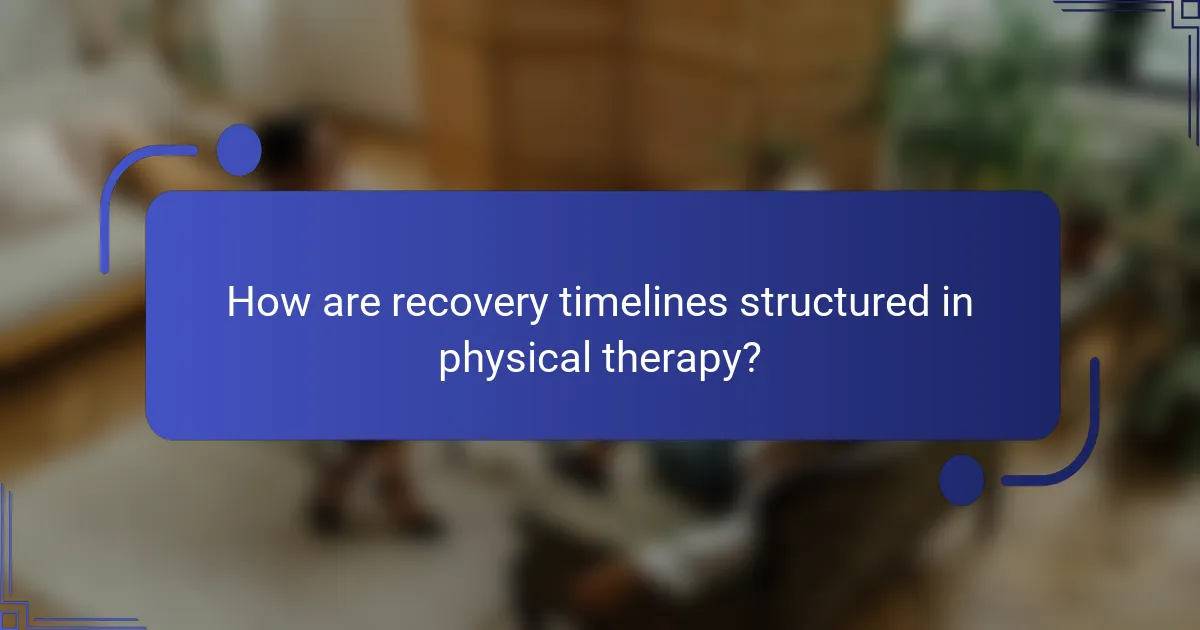
How are recovery timelines structured in physical therapy?
Recovery timelines in physical therapy are structured based on injury severity, treatment goals, and patient progress. Typically, timelines range from a few weeks to several months.
Initial assessments determine the recovery phase, which includes acute, subacute, and chronic stages. Each phase has specific goals, such as pain reduction, mobility improvement, and strength building.
For example, a mild sprain may require 2-6 weeks for recovery, while a surgical rehabilitation could extend to 6 months or more. Regular evaluations adjust timelines as needed, ensuring personalized care.
Factors influencing recovery include age, overall health, and adherence to therapy. Effective communication with the therapist enhances outcomes and can accelerate recovery.
What factors influence recovery duration?
Recovery duration is influenced by factors such as injury severity, age, overall health, and adherence to therapy. Each factor can significantly impact healing time. For example, severe injuries typically require longer rehabilitation than minor ones. Age plays a role; younger individuals often heal faster due to better tissue regeneration. Overall health, including pre-existing conditions, can affect recovery speed. Finally, consistent participation in physical therapy sessions can enhance recovery timelines.
How do rehabilitation milestones vary by injury type?
Rehabilitation milestones vary significantly by injury type, impacting recovery timelines and approaches. For example, soft tissue injuries typically see milestones like pain reduction and mobility restoration within weeks, while fractures may require months for full healing and weight-bearing activities.
| Injury Type | Initial Milestone | Mid-Recovery Milestone | Final Milestone |
|———————|——————————|—————————–|——————————-|
| Soft Tissue Injury | Pain reduction (2-4 weeks) | Improved mobility (4-6 weeks) | Full function (2-3 months) |
| Fracture | Immobilization (0-2 weeks) | Weight-bearing (6-8 weeks) | Full activity (3-6 months) |
| Ligament Tear | Pain management (1-2 weeks) | Range of motion (4-6 weeks) | Return to sport (6-12 months)|
| Tendon Injury | Pain relief (1-3 weeks) | Strengthening (4-8 weeks) | Full function (3-6 months) |
What common timelines exist for specific injuries?
Common timelines for specific injuries vary based on the type and severity of the injury. Generally, mild injuries like sprains may take 1 to 3 weeks for recovery, while moderate injuries can require 4 to 6 weeks. Severe injuries, such as fractures, often necessitate 6 to 12 weeks or longer for full rehabilitation. Factors influencing these timelines include the individual’s age, overall health, and adherence to physical therapy protocols. Consistent therapy can expedite recovery and improve outcomes.

Which patient demographics benefit most from physical therapy?
Individuals with musculoskeletal injuries, older adults, and post-surgical patients benefit most from physical therapy. These demographics often require tailored rehabilitation approaches to enhance recovery. For example, older adults may experience age-related mobility issues, making physical therapy essential for maintaining independence. Additionally, those recovering from surgery often need specific rehabilitation to regain strength and function. Research indicates that personalized physical therapy can significantly reduce recovery timelines and improve overall outcomes for these groups.
How do age and activity level affect rehabilitation outcomes?
Age and activity level significantly influence rehabilitation outcomes. Older individuals may experience slower recovery due to factors like decreased muscle mass and joint mobility. Active individuals often recover faster, benefiting from better physical conditioning and resilience. Studies show that tailored physical therapy can enhance recovery for both demographics, addressing their unique needs.
What considerations are there for athletes in physical therapy?
Athletes in physical therapy must consider factors such as individualized treatment plans, injury types, recovery timelines, and rehabilitation goals. Tailoring therapy to specific needs enhances recovery effectiveness.
1. Individual Assessment: Each athlete requires a unique evaluation to identify specific injuries and functional limitations.
2. Treatment Techniques: Various methods, including manual therapy, exercise regimens, and modalities, should be incorporated based on the athlete’s needs.
3. Recovery Timeline: Understanding the expected duration of rehabilitation helps athletes set realistic goals and timelines for returning to their sport.
4. Communication: Continuous dialogue between the athlete, therapist, and coaching staff ensures alignment on recovery progress and adjustments to the rehabilitation plan.
How does the rehabilitation process differ for chronic vs. acute injuries?
The rehabilitation process for chronic injuries typically involves a longer duration and a focus on managing ongoing pain, while acute injuries often require immediate intervention and faster recovery strategies. Chronic injury rehabilitation emphasizes gradual strength building and functional training, often incorporating pain management techniques. Acute injury rehabilitation prioritizes restoring range of motion and stability through initial rest and specific exercises. Additionally, chronic injuries may necessitate lifestyle modifications to prevent recurrence, whereas acute injuries often involve a more straightforward return to previous activity levels.
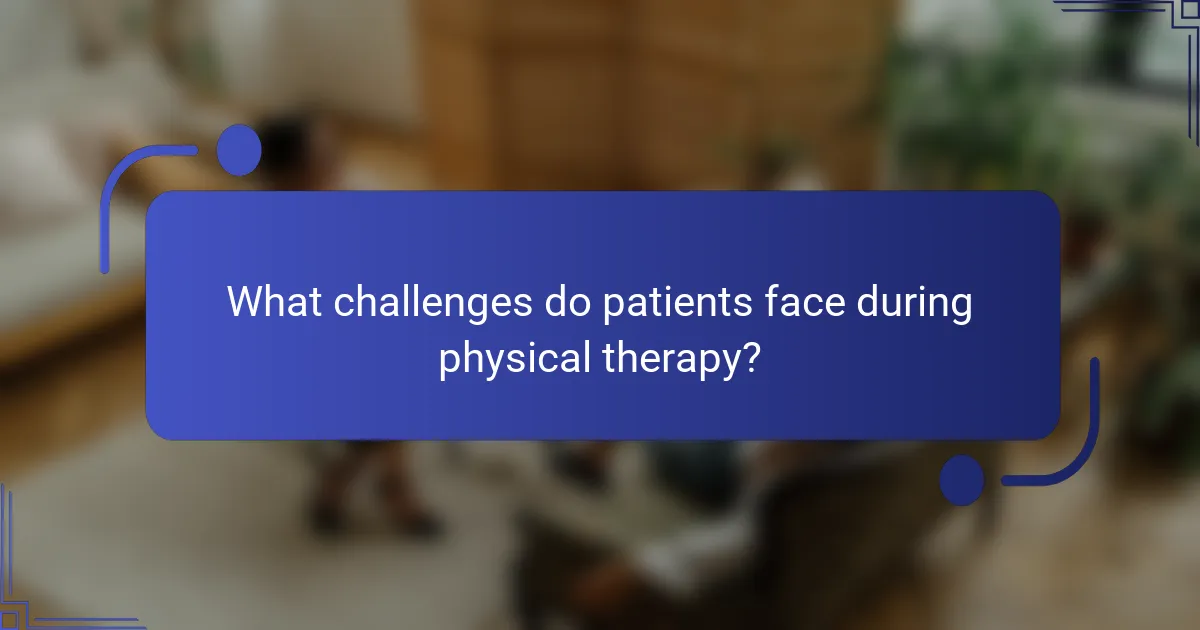
What challenges do patients face during physical therapy?
Patients face several challenges during physical therapy, including pain management, motivation, and adherence to exercise regimens. Pain can limit participation and hinder progress. Maintaining motivation is crucial, as recovery can be slow and frustrating. Adhering to prescribed exercises often requires discipline, and some patients struggle with consistency. Additionally, patients may encounter logistical issues, such as transportation difficulties or scheduling conflicts, which can further impede their rehabilitation journey.
How can patients overcome psychological barriers to recovery?
Patients can overcome psychological barriers to recovery through supportive therapies and mindset shifts. Engaging in physical therapy fosters a sense of control and encourages progress, which can alleviate anxiety. Cognitive-behavioral strategies help patients reframe negative thoughts about their injury and recovery.
Building a support network with family, friends, and professionals can enhance motivation and provide emotional backing. Setting realistic goals in therapy allows patients to celebrate small victories, reinforcing a positive outlook.
Practicing mindfulness and relaxation techniques can reduce stress and improve focus on rehabilitation. These approaches collectively address the psychological aspects of recovery, promoting a more holistic healing process.
What common mistakes hinder progress in rehabilitation?
Common mistakes that hinder progress in rehabilitation include inadequate communication with therapists, neglecting prescribed exercises, and setting unrealistic goals. These errors can delay recovery and reduce effectiveness.
1. Poor communication with therapists can lead to misunderstandings about treatment plans.
2. Skipping or not following through on prescribed exercises limits physical progress.
3. Setting unrealistic goals can cause frustration and decreased motivation.
4. Ignoring pain signals may exacerbate injuries and prolong recovery.
5. Failing to maintain a balanced diet can impact overall healing and energy levels.
How can patients stay motivated throughout their therapy journey?
Patients can stay motivated throughout their therapy journey by setting clear goals, tracking progress, and maintaining a support network. Establishing specific, achievable objectives helps patients visualize their recovery. Regularly monitoring advancements reinforces their commitment and encourages perseverance. Engaging family and friends provides emotional support, fostering a positive environment. Additionally, celebrating milestones boosts morale and reinforces motivation.

What are the emerging trends in physical therapy for injury rehabilitation?
Emerging trends in physical therapy for injury rehabilitation include personalized treatment plans, telehealth services, and the integration of technology. These trends enhance patient engagement and improve recovery outcomes. Personalized approaches consider individual needs, while telehealth expands access to care. Technology, such as wearable devices, provides real-time data for monitoring progress. As a result, these innovations lead to more efficient and effective rehabilitation processes.
How is telehealth changing the landscape of physical therapy?
Telehealth is transforming physical therapy by enhancing accessibility and convenience for patients. Remote consultations allow therapists to evaluate and guide rehabilitation without the need for in-person visits. This approach increases patient engagement through flexible scheduling and reduces travel time, which can lead to improved adherence to treatment plans.
Moreover, telehealth facilitates the use of digital tools for monitoring progress, such as mobile apps and wearable technology. These tools provide real-time data, allowing therapists to adjust treatment strategies based on patient feedback and performance.
Research indicates that telehealth can lead to comparable outcomes to traditional in-person therapy, especially for conditions like musculoskeletal injuries. This shift is particularly beneficial for patients in rural areas or those with mobility challenges, ensuring they receive timely care.
Overall, telehealth is reshaping physical therapy by making it more accessible, efficient, and patient-centered, ultimately enhancing recovery timelines and outcomes.
What role does personalized medicine play in rehabilitation?
Personalized medicine significantly enhances rehabilitation by tailoring treatment plans to individual patient needs. This approach considers unique genetic, environmental, and lifestyle factors, leading to more effective recovery strategies. For example, personalized assessments can determine the most suitable physical therapy techniques for specific injuries, improving patient outcomes. Additionally, incorporating patient feedback into rehabilitation plans fosters a collaborative environment, which can accelerate recovery timelines. Overall, personalized medicine optimizes rehabilitation by focusing on the individual, ensuring that interventions are relevant and effective.
Which innovative therapies are gaining traction in the field?
Innovative therapies gaining traction in physical therapy for injury rehabilitation include virtual reality therapy, dry needling, and blood flow restriction training. These approaches enhance recovery by improving engagement, reducing pain, and optimizing muscle strength. Virtual reality therapy immerses patients in interactive environments, increasing motivation and adherence. Dry needling targets myofascial pain, promoting faster healing. Blood flow restriction training allows patients to achieve muscle gains with lower loads, minimizing stress on injured areas.
What best practices should patients follow for effective recovery?
Patients should follow specific best practices for effective recovery during physical therapy. Adhering to prescribed exercises enhances strength and mobility. Consistent communication with the therapist ensures personalized adjustments to the recovery plan. Maintaining a healthy diet supports tissue healing and overall wellness. Setting realistic goals fosters motivation and progress tracking. Lastly, prioritizing rest and recovery time prevents setbacks and promotes long-term success.
